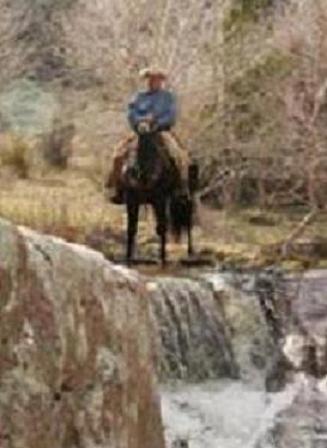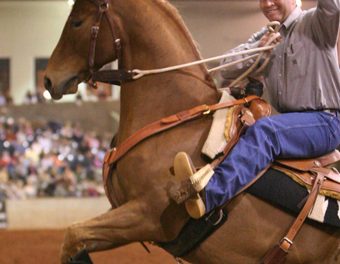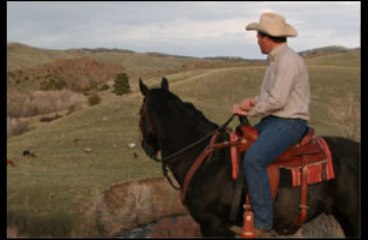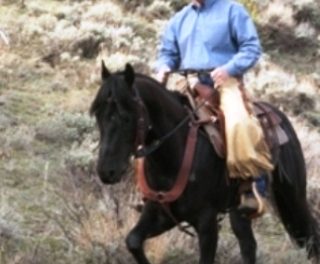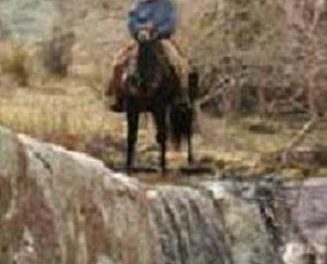 Some horses are afraid or nervous when you try to bathe them. This can be very frustrating and has the potential to be dangerous for you and your horse. This month, we will discuss how to get your horse accustomed to bathing and water on his body and how you can adapt your training philosophy to make the entire process relaxed and safe for both of you. For these exercises you will need a halter and lead rope, and a hose with a spray nozzle.
Some horses are afraid or nervous when you try to bathe them. This can be very frustrating and has the potential to be dangerous for you and your horse. This month, we will discuss how to get your horse accustomed to bathing and water on his body and how you can adapt your training philosophy to make the entire process relaxed and safe for both of you. For these exercises you will need a halter and lead rope, and a hose with a spray nozzle.
The biggest thing in terms of training philosophy that I want to stress here is breaking your goals down in to small pieces. If you break each lesson in to the smallest steps you can think of, you can effectively change your horse’s thinking about any topic. This applies across all areas of training, not just when you are teaching your horse to accept bathing. In this case, don’t start with your goal of “giving your horse a bath”. Break the exercise down and start with the first small piece.
Take your horse to the bathing area. Do not straight tie him or cross tie him. I like to keep the lead rope in my hand so I can direct my horse’s movement and so that he has the freedom to move around if he gets nervous. I want him to make the choice to stand and quietly and calmly accept bathing, not stand still because I force him to. Start by turning the water on pointing away from your horse. Keep an eye on him out of the corner of your eye but you are more or less going to ignore him. Just see how he reacts. When your horse stops looking at the water and brings his attention back to you on his own, turn off the water and pet him. Then turn the water back on and move it a little closer, still ignoring your horse. If he starts moving around trying to get away from the water, you can use the stream from the hose to direct his motion. You are not chasing him with it, but using it as a tool to direct him. Direct him back and forth until his feet stop moving. As soon as he stands still, turn off the water and reward him.
As you move the water closer and closer to your horse, if he moves away just follow him with the water and allow him to longe around you. As soon as he makes the decision to stop his feet, turn off the water as his reward. The goal here is not to desensitize your horse, but to teach him to control his emotions. Once your horse will stand still when you turn on the water and move it around him, you are ready to start actually touching him with the water. Start at his feet, just touching his hoof area with the spray. One reason I think it is so important to allow your horse the choice to move around in the early parts of this exercise is that if you tie him and restrain him you are taking away his natural ability to flee. When you do this, it can cause your horse to build emotional pressure until he blows up. Direct his energy, but don’t try to stop it. Wait for him to make the decision to stand still on his own. I will only stop my horse’s movement in this exercise if he starts acting rude and trying to run over the top of me or push in to me. In that case, stop him and reinforce your boundaries. He can move, but he still needs to be polite about it!
From the hoof, work gradually up the legs. As you progress, you can stop turning the water completely off as a reward and just move it away from your horse when he stands still. Keep working over your horse’s body, up the legs to the shoulders and over the back to the hindquarters. He will need to stop and stand still for longer and longer periods before you take the water away as you progress through this exercise.
When you are ready to rinse your horse, get a friend to help you. Bring your horse to a tie post, but don’t actually tie him. You are going to have your friend act as a tie by wrapping the lead rope once around the post but standing there ready to unwind it quickly if needed. Don’t get into a fight with your horse. If he seems anxious once he is tied, untie him and take a few steps back in your progression to a place where he is comfortable again and work there for a while before trying the next step again. You don’t want to push your horse until he makes a mistake so you can correct him. You want to set him up for success. Reward him when he tries, even if it is a small try at first. And remember, you want him to be calm and relaxed at the end of this process. Take your time and build a solid foundation where your horse accepts what you are doing and learns to control his own emotions when new things come along.
Enjoy your horses, and until next time, may God bless the trails you ride.
For more information on Ken McNabb’s programs call us at 307-645-3149 or go to www.kenmcnabb.com.
For these exercises you will need a halter and lead rope, and a hose with a spray nozzle.
The biggest thing in terms of training philosophy that I want to stress here is breaking your goals down in to small pieces. If you break each lesson in to the smallest steps you can think of, you can effectively change your horse’s thinking about any topic. This applies across all areas of training, not just when you are teaching your horse to accept bathing. In this case, don’t start with your goal of “giving your horse a bath”. Break the exercise down and start with the first small piece.
Take your horse to the bathing area. Do not straight tie him or cross tie him. I like to keep the lead rope in my hand so I can direct my horse’s movement and so that he has the freedom to move around if he gets nervous. I want him to make the choice to stand and quietly and calmly accept bathing, not stand still because I force him to. Start by turning the water on pointing away from your horse. Keep an eye on him out of the corner of your eye but you are more or less going to ignore him. Just see how he reacts. When your horse stops looking at the water and brings his attention back to you on his own, turn off the water and pet him. Then turn the water back on and move it a little closer, still ignoring your horse. If he starts moving around trying to get away from the water, you can use the stream from the hose to direct his motion. You are not chasing him with it, but using it as a tool to direct him. Direct him back and forth until his feet stop moving. As soon as he stands still, turn off the water and reward him.
As you move the water closer and closer to your horse, if he moves away just follow him with the water and allow him to longe around you. As soon as he makes the decision to stop his feet, turn off the water as his reward. The goal here is not to desensitize your horse, but to teach him to control his emotions. Once your horse will stand still when you turn on the water and move it around him, you are ready to start actually touching him with the water. Start at his feet, just touching his hoof area with the spray. One reason I think it is so important to allow your horse the choice to move around in the early parts of this exercise is that if you tie him and restrain him you are taking away his natural ability to flee. When you do this, it can cause your horse to build emotional pressure until he blows up. Direct his energy, but don’t try to stop it. Wait for him to make the decision to stand still on his own. I will only stop my horse’s movement in this exercise if he starts acting rude and trying to run over the top of me or push in to me. In that case, stop him and reinforce your boundaries. He can move, but he still needs to be polite about it!
From the hoof, work gradually up the legs. As you progress, you can stop turning the water completely off as a reward and just move it away from your horse when he stands still. Keep working over your horse’s body, up the legs to the shoulders and over the back to the hindquarters. He will need to stop and stand still for longer and longer periods before you take the water away as you progress through this exercise.
When you are ready to rinse your horse, get a friend to help you. Bring your horse to a tie post, but don’t actually tie him. You are going to have your friend act as a tie by wrapping the lead rope once around the post but standing there ready to unwind it quickly if needed. Don’t get into a fight with your horse. If he seems anxious once he is tied, untie him and take a few steps back in your progression to a place where he is comfortable again and work there for a while before trying the next step again. You don’t want to push your horse until he makes a mistake so you can correct him. You want to set him up for success. Reward him when he tries, even if it is a small try at first. And remember, you want him to be calm and relaxed at the end of this process. Take your time and build a solid foundation where your horse accepts what you are doing and learns to control his own emotions when new things come along.
Enjoy your horses, and until next time, may God bless the trails you ride.
For more information on Ken McNabb’s programs call us at 307-645-3149 or go to www.kenmcnabb.com.

